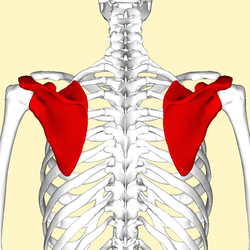Shoulder blade
| Scapula | |
|---|---|
 |
|

The upper picture is an anterior (from the front) view of the thorax and shoulder girdle. The lower picture is a posterior (from the rear) view of the thorax (scapula shown in red.)
|
|
| Details | |
| Identifiers | |
| Latin | Scapula (omo) |
| MeSH | A02.835.232.087.783 |
| TA | A02.4.01.001 |
| FMA | 13394 |
|
Anatomical terms of bone
[]
|
|
In anatomy, the scapula (plural scapulae or scapulas) or shoulder blade is the bone that connects the humerus (upper arm bone) with the clavicle (collar bone). Like their connected bones the scapulae are paired, with the scapula on the left side of the body being roughly a mirror image of the right scapula. In early Roman times, people thought the bone resembled a trowel, a small shovel. The shoulder blade is also called omo in Latin medical terminology.
The scapula forms the back of the shoulder girdle. In humans, it is a flat bone, roughly triangular in shape, placed on a posterolateral aspect of the thoracic cage.
The scapula is a wide, flat bone lying on the thoracic wall that provides an attachment for three different groups of muscles. The intrinsic muscles of the scapula include the muscles of the rotator cuff—the subscapularis, teres minor, supraspinatus, and infraspinatus. These muscles attach to the surface of the scapula and are responsible for the internal and external rotation of the shoulder joint, along with humeral abduction. The extrinsic muscles include the biceps, triceps, and deltoid muscles and attach to the coracoid process and supraglenoid tubercle of the scapula, infraglenoid tubercle of the scapula, and spine of the scapula. These muscles are responsible for several actions of the glenohumeral joint. The third group, which is mainly responsible for stabilization and rotation of the scapula, consists of the trapezius, serratus anterior, levator scapulae, and rhomboid muscles and attach to the medial, superior, and inferior borders of the scapula.
The head, processes, and the thickened parts of the bone, contain cancellous tissue; the rest consists of a thin layer of compact tissue.
...
Wikipedia
